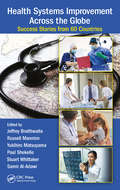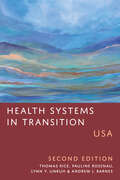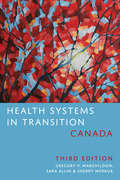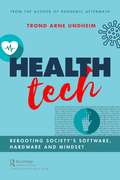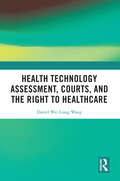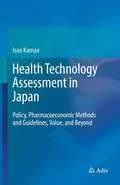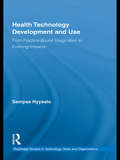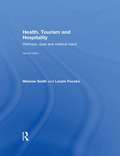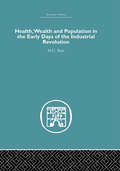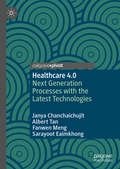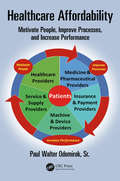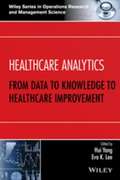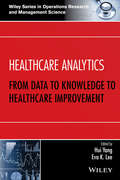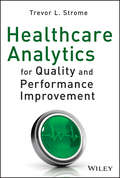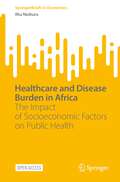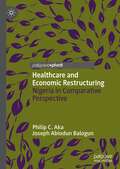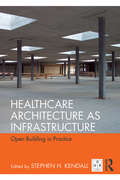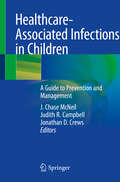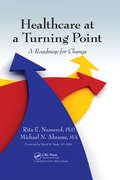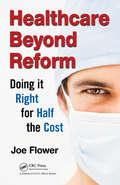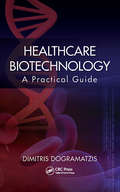- Table View
- List View
Health Stop (B): The Medical Offices
by Regina E. HerzlingerDescribes the long waiting time experienced by customers in Health Stops and asks students to specify the changes in its business model which could help solve the problem.
Health Stop Retail Medical Centers (A): Strategy
by Regina E. Herzlinger Joyce Lallman Nancy M. KaneReviews the different business models of for-profit chains that provide ambulatory health care services and asks the students to evaluate which is most likely to do good and do well. It is an effective case for introducing the framework for how to evaluate health care innovations.
Health Stop Retail Medical Centers (A): Strategy
by Joyce Lallman Nancy M. Kane Regina E. HerzlingerWill Health Stop's strategy and business model enable it to succeed against the many other retail medical center innovations described in the case and why? Health Stop, staffed by doctors and located in the malls of wealthy suburbs, is competing against retail medical centers with very different business models. These include: CVS Minute Clinic (CVS' walk-in clinic), One Medical (a concierge service for primary care), Iora Health (a primary care model charging its members a monthly fixed amount as opposed to the traditional fee-for-service model), and ChenMed (a clinic focused on elderly patients with multiple chronic diseases.) Accompanying this case are the following instructional materials: An analytic framework for discussing the questions in the case. It is Chapter 1, Innovating in Healthcare: Creating Breakthrough Services, Products, and Business Models, Regina E. Herzlinger, Wiley 2022
Health Systems Improvement Across the Globe: Success Stories from 60 Countries
by Jeffrey Braithwaite Russell Mannion Yukihiro Matsuyama Paul Shekelle Stuart Whittaker Samir Al-AdawiFollowing on from 2015’s Healthcare Reform, Quality and Safety: Perspectives, Participants, Partnerships and Prospects in 30 Countries, this book encompasses a global perspective on healthcare while shifting the focus from reform to showcasing success stories of healthcare systems worldwide. It provides explanations of why various facets of healthcare systems work well in different contexts and offers the reader alternative models for consideration. The book features contributions from 60 countries, going much further than the common practice of focusing on affluent Western nations, to provide a comprehensive exploration of the success of healthcare systems globally. The majority of literature on health-sector improvement attempts to address the problems within systems, relating the errors that can and do occur, for example, and offering solutions and preventative strategies. This book of country case studies will approach the enhancement of health systems, patient safety and the quality of care in a new and innovative way, comprehensively surveying and synthesizing the success stories of healthcare systems around the world, utilizing Hollnagel’s Safety-II approach to acknowledge the importance of exploring what goes right, what works well, and why it works. These success stories may include reference to macro, meso or micro levels of healthcare systems, various sectors (e.g., aged care, acute care or primary care), or specific programs or projects. Health System Improvement Across the Globe: Success Stories from 60 Countries is unprecedented in terms of both reach and positive emphasis, and as such will be instrumental in changing ways of thinking about and guiding health-sector improvement.
Health Systems in the Developing World
by Kevin Schulman Muhammed Pate Gary CarbellThis teaching note offers an approach to the evaluation of health care markets globally. The note prepares students with a set of questions about the organization of core elements of the health care system. The organization of these elements can vary across markets, and can vary in terms of the different roles of the public and private sector in financing and delivery of health care services. Overall, the framework provides an opportunity for a structured analysis of any market in health care, and provides students with a comprehensive approach to assessing the current health care market. Students can build from this framework with their own assessments of potential opportunities for business or policy innovation within the market.
Health Systems in Transition: USA, Second Edition
by Thomas Rice Pauline Rosenau Lynn Y. Unruh Andrew J. BarnesThis analysis of the United States health care system reviews developments in organization and governance, health financing, health care provision, health reforms, and health system performance. The U.S. system has both considerable strengths and notable weaknesses. It has a large and well-trained health workforce, a wide range of high-quality medical specialists as well as secondary and tertiary institutions, a robust health sector research program, and, for selected services, among the best medical outcomes in the world. But it also suffers from incomplete coverage of its citizenry, health expenditure levels per person far exceeding all other countries, poor objective and subjective indicators of quality and outcomes, and an unequal distribution of resources and outcomes across the country and among different population groups. Because of the adoption of the Affordable Care Act in 2010, and subsequent revisions to it, the U.S. is facing a period of enormous change. There is a great need to improve coverage and improve equity, better ensure quality outcomes, and find ways to better control expenditures. Health Systems in Transition: USA provides an in-depth discussion of these issues and a thorough review of the U.S. health care system.
Health Systems in Transition: Canada, Third Edition
by Gregory Marchildon Sarah Allin Sherry MerkurThe health care system in Canada receives a great deal of international attention, but it is subject to considerable critique and debate locally. Health Systems in Transition: Canada provides an insightful and objective analysis of the organization, governance, financing, and delivery of health care as well as comparisons between the Canadian system and others internationally. This book draws on a wide range of empirical studies and statistical data within Canada and across comparable countries to provide a thorough description of the many facets of health care in Canada. Drawing on the most reliable and recent data available, this study reveals the strengths and weakness of Canadian health care. This assessment is based on numerous comparisons of Canada to peer countries (Australia, France, Germany, Netherlands, Sweden, the United Kingdom, and the United States) and among provinces and territories within Canada. It will be of interest to scholars and students in Canada wanting to learn more about the largest and most celebrated public program, and for those outside Canada interested in comparative systems and policy research.
Health Tech: Rebooting Society's Software, Hardware and Mindset
by Trond Arne UndheimGlobal healthcare will change drastically in the next decade due to key technologies, social dynamics, and systemic shifts that are already in motion. However, shaping the future requires being aware of the opportunities and able to capitalize on them to one’s family and the community’s benefit. Health tech can be a part of the solution, but tracking the right startups and influencers takes know-how. The grand challenges of our time demand that we coordinate better than ever before. Social movements can both accelerate and slow down change. Health systems across the world need to reboot, with private partnerships and new governance paradigms that have global reach but local legitimacy, but exactly how can this be done considering the collective action problem and complexity involved? Health Tech: Transforming Public Health Innovation at the Edge fulfills the need for actionable insight on what’s truly driving change and how to become a changemaker, not just affected by it. The book introduces anybody who wishes to understand how global healthcare will change in the next decade to key technologies, social dynamics, and systemic shifts that are shaping the future. Healthcare Futurist, investor and entrepreneur, Trond Undheim, describes the complex history of public health, why it’s so complicated and what the major challenges right now. He includes a discussion of COVID, why it happened, the cultural factors that has slowed down traditional public health measures and how innovation can help. He also discusses what is happening in health systems around the world as a result of the pandemic. The book also explores certain health tech measures, tools (basic medical devices gradually being upgraded and digitally enhanced), processes and innovation which are already working well, and others that are in their infancy such as AI, wearables, robotics, sensors, digital therapeutics and others. The author also describes the movers and shakers in the healthcare system of the future from startups to patients and services providers and the health challenges of our time including the pandemic, aging and preventive healthcare and much more. The book concludes with a look at how health tech may provide the biggest opportunity to transform healthcare for decades to come.
Health Technology Assessment, Courts and the Right to Healthcare
by Daniel Wei WangBoth developing and developed countries face an increasing mismatch between what patients expect to receive from healthcare and what the public healthcare systems can afford to provide. Where there has been a growing recognition of the entitlement to receive healthcare, the frustrated expectations with regards to the level of provision has led to lawsuits challenging the denial of funding for health treatments by public health systems. This book analyses the impact of courts and litigation on the way health systems set priorities and make rationing decisions. In particular, it focuses on how the judicial protection of the right to healthcare can impact the institutionalization, functioning and centrality of Health Technology Assessment (HTA) for decisions about the funding of treatment. Based on the case study of three jurisdictions – Brazil, Colombia, and England – it shows that courts can be a key driver for the institutionalization of HTA. These case studies show the paradoxes of judicial control, which can promote accountability and impair it, demand administrative competence and undermine bureaucratic capacities. The case studies offer a nuanced and evidence-informed understanding of these paradoxes in the context of health care by showing how the judicial control of priority-setting decisions in health care can be used to require and control an explicit scheme for health technology assessment, but can also limit and circumvent it. It will be essential for those researching Medical Law and Healthcare Policy, Human Rights Law, and Social Rights.
Health Technology Assessment in Japan: Policy, Pharmacoeconomic Methods and Guidelines, Value, and Beyond
by Isao KamaeRepresenting the first book on the topic, this work offers the reader an introduction to the Japanese systems for health technology assessment (HTA) officially introduced by the Ministry of Health, Labour and Welfare (MHLW) in 2016. Policy and guidelines are discussed, with the relevant methods and conditions of cost-effectiveness analysis explained alongside. Numerous instructive examples and exercises, ranging from basic to advanced, impart valuable knowledge and insight on the quantitative methods for economic evaluation, which will appeal to both beginners and experts.This guidebook is authored by Japan’s foremost expert in HTA and pharmacoeconomics, with a view to strengthening the reader’s expertise in value-based healthcare and decision-making. The methods presented are essential to informing regulatory, local and patient decisions; as such, the book is equally recommended to industry and government, as well as academia, and anyone with an interest in Japanese HTA.
Health Technology Development and Use: From Practice-Bound Imagination to Evolving Impacts (Routledge Studies in Innovation, Organizations and Technology)
by Sampsa HyysaloHow do development and use of new technology relate? How can users contribute to innovation? This volume is the first to study these questions by following particular technologies over several product launches in detail. It examines the emergence of inventive ideas about future technology and uses, how these are developed into products and embedded in health care practices, and how the form and impact of these technologies then evolves through several rounds of design and deployment across different types of organizations. Examining these processes through three case studies of health care innovations, these studies reveal a blind spot in extant research on development-use relations. The majority of studies have examined shorter ‘episodes’: moments within particular design projects, implementation processes, usability evaluations, and human-machine interactions. Studies with longer time-frames have resorted to a relatively coarse ‘grain-size’ of analysis and hence lost sight of how the interchange is actually done. As a result there are no social science, information systems, or management texts which comprehensively or adequately address: • how different moments, sites and modes of shaping new technology determine the evolution of new technology; • the detailed mechanisms of learning, interaction, and domination between different actors and technology during these drawn out processes; and • the relationship of technology projects and the professional practices and social imaginations that are associated in technology development, evaluation, and usage. The "biographies of technologies and practices" approach to new technology advanced in this volume offers us urgent new insight to core empirical and theoretical questions about how and where development projects gain their representations of future use and users, how usage is actually designed, how users’ requests and modifications affect designs, and what kind of learning takes place between developers and users in different phases of innovation—all crucial to our understanding and ability to advance new health technology, and innovation more generally.
Health, Tourism and Hospitality: Spas, Wellness and Medical Travel
by Melanie Smith Laszlo PuczkoHealth, Tourism and Hospitality: Spas, Wellness and Medical Travel, 2nd Edition takes an in-depth and comprehensive look at the growing health, wellness and medical tourism sectors in a global context. The book analyses the history and development of the industries, the way in which they are managed and organised, the expanding range of new and innovative products and trends, and the marketing of destinations, products and services. The only book to offer a complete overview and introduction to health, tourism and hospitality this 2nd Edition has been updated to include: * Expanded coverage to the hospitality sector with a particular focus on spa management.* New content on medical tourism throughout the book, to reflect the worldwide growth in medical travel with more and more countries entering this competitive market.* Updated content to reflect recent issues and trends including: ageing population, governments encouraging preventative health, consumer use of contemporary and alternative therapies, self-help market, impacts of economic recession, spa management and customer loyalty.* New case studies taken from a range of different countries and contexts, and focusing on established or new destinations, products and services such as: conventional medicine, complementary and alternative therapies, lifestyle-based wellness, beauty and cosmetics, healthy nutrition, longevity and anti (or active)-ageing, amongst others. Written in a user friendly style, this is essential reading for students studying health, tourism and hospitality.
Health, Wealth and Population in the Early Days of the Industrial Revolution
by M.C. BuerFirst Published in 2005. Routledge is an imprint of Taylor & Francis, an informa company.
Healthcare 4.0: Next Generation Processes with the Latest Technologies
by Janya Chanchaichujit Albert Tan Fanwen Meng Sarayoot EaimkhongThis book aims to demonstrate the benefits of implementing Industry 4.0 in healthcare services and to recommend a framework to support this implementation. Key topics in this book include: (1) Discovering emerging technologies and techniques to support Healthcare 4.0, this includes the Internet of Things (IOT) , Big data analytics, Blockchain, Artificial Intelligence (AI) , Optimisation and Predictive Analytics; (2) Illustrating some examples of such advanced implementation in Healthcare 4.0; (3) Recommending a development process to develop health technology start-ups and entrepreneurial activities; and (4) Discuss the transformation methodology used to redesign healthcare processes in order to overcome the challenges of implementing a Healthcare 4.0 project.
Healthcare Affordability: Motivate People, Improve Processes, and Increase Performance (Continuous Improvement Series)
by Paul Walter Odomirok, Sr.Healthcare Affordability: Motivate People, Improve Processes, and Increase Performance applies the Theory of Affordability across the Healthcare Enterprise. Affordability is realized when the Value delivered exceeds the Patient’s requirements, while the expense for the quality resources required to deliver that Value is at a Cost less than the revenue received from the competitive pricing applied to the care. The aim of healthcare affordability is to attain performance excellence in all areas across the entire Healthcare Enterprise. The Healthcare Enterprise involves 5 types of providers: Healthcare Providers, Medicine and Pharmaceutical Providers, Machine and Device Providers, Service and Supplier Providers, and Insurance and Payment Providers. Obviously, one key focal point of healthcare affordability is affordable healthcare, a condition that has been chased for decades, but has yet to be achieved. This book provides a useful framework and foundation for any organization to pursue and achieve Affordability. Although there are many methods used to accomplish performance improvement, this approach has been proven successful with many organizations. It integrates strategic vision and direction, with operational goals and objectives and tactical targets and tasks. This book also provides a leadership strategy and structure for change and transformation, and a designed plan to execute an 18-month implementation program. Features: Affords patients and providers a better, faster, safer, and more affordable and profitable experience and approach Offers solutions for current state dilemmas, and provides a framework for future state success Increases the speed of delivery, improves the quality, and decreases the cost of care Provides methods and tools for linking and integrating strategic, operational and tactical goals Healthcare Affordability: Motivate People, Improve Processes, and Increase Performance provides readers with methods and means for solving the complex problem of affordable healthcare.
Healthcare Analytics: From Data to Knowledge to Healthcare Improvement
by Hui Yang Eva K. LeeFeatures of statistical and operational research methods and tools being used to improve the healthcare industry With a focus on cutting-edge approaches to the quickly growing field of healthcare, Healthcare Analytics: From Data to Knowledge to Healthcare Improvement provides an integrated and comprehensive treatment on recent research advancements in data-driven healthcare analytics in an effort to provide more personalized and smarter healthcare services. Emphasizing data and healthcare analytics from an operational management and statistical perspective, the book details how analytical methods and tools can be utilized to enhance healthcare quality and operational efficiency. Organized into two main sections, Part I features biomedical and health informatics and specifically addresses the analytics of genomic and proteomic data; physiological signals from patient-monitoring systems; data uncertainty in clinical laboratory tests; predictive modeling; disease modeling for sepsis; and the design of cyber infrastructures for early prediction of epidemic events. Part II focuses on healthcare delivery systems, including system advances for transforming clinic workflow and patient care; macro analysis of patient flow distribution; intensive care units; primary care; demand and resource allocation; mathematical models for predicting patient readmission and postoperative outcome; physician-patient interactions; insurance claims; and the role of social media in healthcare. Healthcare Analytics: From Data to Knowledge to Healthcare Improvement also features: * Contributions from well-known international experts who shed light on new approaches in this growing area * Discussions on contemporary methods and techniques to address the handling of rich and large-scale healthcare data as well as the overall optimization of healthcare system operations * Numerous real-world examples and case studies that emphasize the vast potential of statistical and operational research tools and techniques to address the big data environment within the healthcare industry * Plentiful applications that showcase analytical methods and tools tailored for successful healthcare systems modeling and improvement The book is an ideal reference for academics and practitioners in operations research, management science, applied mathematics, statistics, business, industrial and systems engineering, healthcare systems, and economics. Healthcare Analytics: From Data to Knowledge to Healthcare Improvement is also appropriate for graduate-level courses typically offered within operations research, industrial engineering, business, and public health departments. HUI YANG, PhD, is Associate Professor in the Harold and Inge Marcus Department of Industrial and Manufacturing Engineering at The Pennsylvania State University. His research interests include sensor-based modeling and analysis of complex systems for process monitoring/control; system diagnostics/ prognostics; quality improvement; and performance optimization with special focus on nonlinear stochastic dynamics and the resulting chaotic, recurrence, self-organizing behaviors. EVA K. LEE, PhD, is Professor in the H. Milton Stewart School of Industrial and Systems Engineering at the Georgia Institute of Technology, Director of the Center for Operations Research in Medicine and HealthCare, and Distinguished Scholar in Health System, Health Systems Institute at both Emory University School of Medicine and Georgia Institute of Technology. Her research interests include health-risk prediction; early disease prediction and diagnosis; optimal treatment strategies and drug delivery; healthcare outcome analysis and treatment prediction; public health and medical preparedness; large-scale healthcare/medical decision analysis and quality improvement; clinical translational
Healthcare Analytics: From Data to Knowledge to Healthcare Improvement (Wiley Series in Operations Research and Management Science)
by Hui Yang Eva K. LeeFeatures of statistical and operational research methods and tools being used to improve the healthcare industry With a focus on cutting-edge approaches to the quickly growing field of healthcare, Healthcare Analytics: From Data to Knowledge to Healthcare Improvement provides an integrated and comprehensive treatment on recent research advancements in data-driven healthcare analytics in an effort to provide more personalized and smarter healthcare services. Emphasizing data and healthcare analytics from an operational management and statistical perspective, the book details how analytical methods and tools can be utilized to enhance healthcare quality and operational efficiency. Organized into two main sections, Part I features biomedical and health informatics and specifically addresses the analytics of genomic and proteomic data; physiological signals from patient-monitoring systems; data uncertainty in clinical laboratory tests; predictive modeling; disease modeling for sepsis; and the design of cyber infrastructures for early prediction of epidemic events. Part II focuses on healthcare delivery systems, including system advances for transforming clinic workflow and patient care; macro analysis of patient flow distribution; intensive care units; primary care; demand and resource allocation; mathematical models for predicting patient readmission and postoperative outcome; physician–patient interactions; insurance claims; and the role of social media in healthcare. Healthcare Analytics: From Data to Knowledge to Healthcare Improvement also features: • Contributions from well-known international experts who shed light on new approaches in this growing area • Discussions on contemporary methods and techniques to address the handling of rich and large-scale healthcare data as well as the overall optimization of healthcare system operations • Numerous real-world examples and case studies that emphasize the vast potential of statistical and operational research tools and techniques to address the big data environment within the healthcare industry • Plentiful applications that showcase analytical methods and tools tailored for successful healthcare systems modeling and improvement The book is an ideal reference for academics and practitioners in operations research, management science, applied mathematics, statistics, business, industrial and systems engineering, healthcare systems, and economics. Healthcare Analytics: From Data to Knowledge to Healthcare Improvement is also appropriate for graduate-level courses typically offered within operations research, industrial engineering, business, and public health departments.
Healthcare Analytics for Quality and Performance Improvement
by Trevor L. StromeImprove patient outcomes, lower costs, reduce fraud--all with healthcare analytics Healthcare Analytics for Quality and Performance Improvement walks your healthcare organization from relying on generic reports and dashboards to developing powerful analytic applications that drive effective decision-making throughout your organization. Renowned healthcare analytics leader Trevor Strome reveals in this groundbreaking volume the true potential of analytics to harness the vast amounts of data being generated in order to improve the decision-making ability of healthcare managers and improvement teams. Examines how technology has impacted healthcare delivery Discusses the challenge facing healthcare organizations: to leverage advances in both clinical and information technology to improve quality and performance while containing costs Explores the tools and techniques to analyze and extract value from healthcare data Demonstrates how the clinical, business, and technology components of healthcare organizations (HCOs) must work together to leverage analytics Other industries are already taking advantage of big data. Healthcare Analytics for Quality and Performance Improvement helps the healthcare industry make the most of the precious data already at its fingertips for long-overdue quality and performance improvement.
Healthcare and Disease Burden in Africa: The Impact of Socioeconomic Factors on Public Health (SpringerBriefs in Economics)
by Ilha NiohuruThis open access book evaluates African healthcare systems from multiple perspectives. By examining empirical data from various African countries, it analyzes the effects of socioeconomic factors such as urbanization, population growth, and education on various health indicators, including the situation of health professionals, patients's decision making, health resource distribution, mortality rates, and the burden of disease. Furthermore, topics such as the use of social media in healthcare and insurance policy in Africa are addressed. This book appeals to scholars and professionals interested in healthcare in Africa.
Healthcare and Economic Restructuring: Nigeria in Comparative Perspective
by Philip C. Aka Joseph Abiodun BalogunThis book explores the intersection between healthcare delivery and national economic health, using Nigeria as case study and window into the world. Specifically, the issue this book tackles revolves around how to repair Nigeria’s dysfunctional healthcare system through the medium of a healthier economy that provides sufficient revenue to meet the healthcare needs of citizens.
Healthcare Architecture as Infrastructure: Open Building in Practice (Open Building)
by Stephen H. KendallArchitects and healthcare clients are increasingly coming to recognize that, once built, healthcare facilities are almost immediately subject to physical alterations which both respond to and affect healthcare practices. This calls into question the traditional ways in which these facilities are designed. If functions and practices are subject to alteration, the standard approach of defining required functions and practices before acquiring facilities is obsolete. We need other starting points, working methods, and ways of collaborating. Healthcare Architecture as Infrastructure presents these new approaches. Advocating an infrastructure theory of built environment transformation in which design and investment decisions are organized hierarchically and transcend short-term use, the book draws the practice and research of a number of architects from around the world. Written by experts with experience in policy making, designing, building, and managing complex healthcare environments, it shows professionals in architecture, engineering, healthcare and facilities management how to enhance the long-term usefulness of their campuses and their building stock and how to strengthen their physical assets with the capacity to accommodate a quickly evolving healthcare sector.
Healthcare-Associated Infections in Children: A Guide to Prevention and Management
by J. Chase McNeil Judith R. Campbell Jonathan D. CrewsWith advances in technology and medical science, children with previously untreatable and often fatal conditions, such as congenital heart disease, extreme prematurity and pediatric malignancy, are living longer. While this is a tremendous achievement, pediatric providers are now more commonly facing challenges in these medical complex children both as a consequence of their underlying disease and the delivery of medical care. The term healthcare-associated infections (HAIs) encompass both infections that occur in the hospital and those that occur as a consequence of healthcare exposure and medical complexity in the outpatient setting. HAIs are associated with substantial morbidity and mortality for the individual patient as well as seriously taxing the healthcare system as a whole. In studies from the early 2000s, over 11% of all children in pediatric intensive care units develop HAIs and this figure increases substantially if neonatal intensive care units are considered. While progress has been made in decreasing the rates of HAI in the hospital, these infections remain a major burden on the medical system. In a study published in 2013, the annual estimated costs of the five most common HAIs in the United States totaled $9.8 billion. An estimated 648,000 patients developed HAIs in hospitals within the US in 2011 and children with healthcare-associated bloodstream infection have a greater than three-fold increased risk of death.While a number of texts discuss HAIs in the broader context of infectious diseases or pediatric infectious diseases (such as Mandell’s Principles and Practice of Infectious Diseases or Long and Pickering’s Principles and Practice of Pediatric Infectious Diseases) no single text specifically focuses on the epidemiology, diagnosis and management of HAI in children. Many infectious diseases texts are organized based on the microbiology of infection and from this starting point then discussing the clinical syndromes associated with the organism of interest. For instance, a chapter on Staphylococcus aureus may contain a brief discussion of the role of S. aureus in surgical site infections in the wider context of all staphylococcal disease. For clinicians caring for children at the bedside, however, the clinical syndrome is typically appreciated and intervention necessary prior to organism identification. We propose a text that details both the general principles involved in HAIs and infection prevention but also provides a problem oriented approach. Such a text would be of interest to intensivists, neonatologists, hospitalists, oncologists, infection preventionists and infectious diseases specialists. The proposed text will be divided into three principle sections: 1) Basic Principles of Infection Control and Prevention, 2) Major Infectious Syndromes and 3) Infections in Vulnerable Hosts. Chapters in the Major Infectious Syndromes section will include discussion of the epidemiology, microbiology, clinical features, diagnosis, medical management (or surgical management as appropriate) and prevention of the disease entity of interest. Chapters will seek to be evidenced based as much as possible drawing from the published medical literature as well as from clinical practice guidelines (such as those from the Infectious Diseases Society of America) when applicable. We intend to include tables, figures and algorithms as appropriate to assist clinicians in the evaluation and management of these often complex patients. Finally, we intend to invite authors to participate in this project from across a number of medical specialties including infectious diseases, infection control, critical care, oncology and surgery to provide a multidisciplinary understanding of disease. It is our intent to have many chapters be co-written by individuals in different subspecialties; for instance, a chapter on ventilator-associated pneumonia may be co-written by both infectious disease and critical care medicine specialists. Such a unique text has the potential to provide important guidance for clinicians car
Healthcare at a Turning Point: A Roadmap for Change
by Rita E. Numerof Michael AbramsIf the furious debate around the state of healthcare in the US has led to any consensus, it‘s that the system should be delivering better quality for less cost than it does. The truth is that our healthcare system is a sprawling mix of competing interests in which those of the patient are valued least. Too much discussion has devolved to simplistic
Healthcare Beyond Reform: Doing It Right for Half the Cost
by Joe FlowerThere is a secret inside healthcare, and it‘s this: We can do healthcare for a lot less money. The only way to do that is to do it a lot better. We know it‘s possible because it is happening now. In pockets and branches across healthcare, people are receiving better healthcare for a lot less. Some employers, states, tribes, and health systems are d
Healthcare Biotechnology: A Practical Guide
by Dimitris DogramatzisForeseeing and planning for all of the possibilities and pitfalls involved in bringing a biotechnology innovation from inception to widespread therapeutic use takes strong managerial skills and a solid grounding in biopharmaceutical research and development procedures. Unfortunately there has been a dearth of resources for this aspect of the field.

